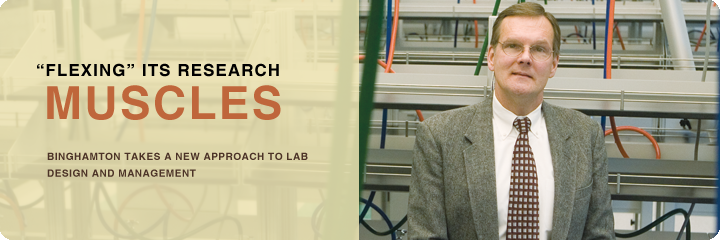
Working in a dark, dank, cavernous laboratory, with only the aid of a fortuitous lightning strike and his faithful assistant Igor, Dr. Frankenstein, one of popular culture’s most fabled fictional researchers, supposedly discovered the very secret of life.
Modern life-science researchers are tackling challenges of near equal complexity, but that’s where the similarity ends. Today’s biomedical, biotechnology and bioengineering researchers are helping to improve quality of life, enhance health care, ensure homeland security and enable exploration of the universe, and the interlocking supports that help to advance their research bear no resemblance to cinematic stereotypes of old.
Which is why Binghamton University researchers and administrators are so excited about the addition of 37,000 square feet of new state-of-the-art laboratory space at the Innovative Technologies Complex, said Stephen Gilje, associate vice president for research.
The new facilities comprise 30,000 square feet of core facilities and flexible laboratory space, as well as two new bioengineering teaching labs, and a 7,000-square-foot clinical science and engineering research facility in the life-sciences research building. Core facilities house common pieces of equipment, including autoclaves, tissue-culture equipment and a high-powered computer lab. Flexible laboratories are designed with as much of the infrastructure as possible — plumbing, electricity and HVAC — in the ceilings, and are furnished with lab benches that can be readily moved with a motorized hand-truck.
This new approach to design and management of laboratory space allows the University to quickly respond to the expansion and contraction of particular research programs, and permits individual researchers or groups of researchers to add or remove equipment or change the laboratory configuration in a matter of days rather than months, Gilje said.
“This is just what we needed when we needed it,“ he added. The University, which hopes to double its research activity over the next five years, last year saw a 24 percent increase in sponsored research activity, despite a dearth of laboratory space and a flat federal funding profile for research.
The new facilities for biomedicine, bioengineering and biotechnology research officially opened in October 2006, with the completion of the first biomedical and biotechnology research suite. Laboratories in the facility are equipped with many pieces of cutting-edge equipment and modern laboratory benches and are designed with flexibility and collaboration in mind, Gilje said. They are also helping the University to recruit bright young faculty and graduate students — and that can only help to advance the University’s research initiatives, he added.
To optimize their chances for success in today’s competitive research climate, junior and senior life-science researchers alike need a number of other supports that the ITC labs will provide. Perhaps first among them are opportunities to engage in cross- and multidisciplinary collaborations, said Gerald Sonnenfeld, vice president for research.
Sonnenfeld ought to know. He is an eminent immunologist whose research into the effects of stress on the immune system has multiple sponsors, including the National Aeronautics and Space Administration. He is engaged in collaborative projects with colleagues at home and abroad, including a recent collaboration with Dr. Karen Burg of Clemson University, with whom Sonnenfeld is trying to develop, through tissue engineering, lymphoid tissue that will allow testing of new vaccines even before they are used on animals or humans.
In a world where advances in technology and knowledge are blurring the lines and leading to an enmeshment of major scientific disciplines, collaboration is critical to researchers who want to stay at the leading edge of inquiry, Sonnenfeld said.
“Science has progressed and changed so that now research techniques that apply to one area are often useful across the board. That means today, if I want to be a good immunologist, I have to know about proteomics, genomics, bioengineering, chemistry and physics, where 20 years ago I didn’t have to know much about these things,“ he said. “As a researcher, the greatest benefit to me of these new facilities is the potential for collaboration that they afford. It’s a very powerful tool to have.“
Omowunmi Sadik, professor of bioanalytical, materials and environmental chemistry, and director of the Center for Advanced Sensors and Environmental Systems, agrees.
“Our group is working with industrial sponsors to utilize flexible substrates for fabrication of new sensors and devices,“ she said. “Our activities rely on the need to interact directly or indirectly with other ITC occupants, such as the Center of Excellence, and Start-Up companies with interests in commercialization. This could foster innovation in the area of sensors and environmental monitoring, and help translate sensor research into finished products.“
page 1 | page 2